Epithelial Tissue That Can Stretch or Is Subjected to Stress Would Have Many
3 Epithelial tissues
Epithelial tissues embrace all external and internal surfaces of the body. Think virtually information technology as a compress wrap that continues into torso cavities. If the endoscope can become there without puncturing the skin or mucosal membranes and "drawing claret", the surface is covered by epithelium. Pare is covered by epithelium (that'due south the epidermis layer), lips are covered by epithelium, the mouth crenel is, too equally the esophagus, stomach and intestines, you get the picture show. Another organ system that branches off from the oral cavity is the respiratory system; so the trachea, bronchi, and all the way to the alveoli in the lungs, are covered by epithelium. Don't forget that epithelium too covers places like the cornea, sclera of the eye, and the tympanic membrane in the ear.
In several places, epithelial sheets roll upward into tubes and grade the ducts of exocrine glands. Some epithelia course the majority of the organ, equally seen in the thyroid gland and the liver. I bet yous have never thought of the liver every bit a specialized epithelial tissue.
One particular type of epithelium, known as endothelium, lines all blood vessels, including capillaries and the chambers of the center. After all, blood vessels are hollow organs filled with blood. This epithelium has one important feature, it has anti-coagulation properties. The blood never sticks to information technology.
All epithelial tissues have these common characteristics:
- They grade sheets of tightly jump cells or curlicue into tubes.
- Epithelial cells lie on the basement membrane.
- Epithelial cells have 2 unlike "sides"—apical and basolateral.
- The upmost side always faces out of the body (exterior or into a lumen).
- There is a small amount, or an absenteeism of, extracellular matrix.
- They are avascular (meaning, they don't have blood vessels) and become their nutrients via diffusion.
- They have a high regenerative potential.
In addition to these common characteristics, epithelium has differences based on its location and function in the body. Information technology is either thicker or thinner, it might secrete mucus, or it can attain special surface modifications to help its purpose. Surfaces that experience annoying forces, such as the skin or the cornea, have multiple-layered epithelium, while single-layered epithelium is sufficient to encompass internal organs. Epithelium in the upper respiratory arrangement has cilia, membrane extensions that resemble tiny hairs. The epidermis of the peel maintains a layer of keratin fibers on top.
Epithelial tissues differ in the following ways:
- Number of layers in the epithelial canvass.
- The shape of the cells.
- Apical surface modifications.
- Boosted functions (the primary role is always to create a barrier).
4.2.i Classification of epithelia – number of cell layers
Based on the number of layers, epithelium can be classified every bit:
- Simple
- Stratified
- Pseudostratified
Simple epithelium has one layer of cells lying on the basement membrane. Stratified epithelium has two or more than layers of cells stacked on peak of i another, usually to increase the strength of the barrier. Simple epithelia are found in places where there is not much mechanical impact on the surface, while stratified epithelia are located in places subject to more mechanical force.
At that place is likewise an exception, a single layered epithelium that appears multilayered nether the microscope because the nuclei of the cells are at dissimilar levels. It is called pseudostratified (every bit in faux-looking stratified).
iv.2.ii.Classification of epithelia – shape of the cells
Based on shape, epithelial cells can be classified into one of 3 groups:
- Squamous
- Cuboidal
- Columnar
Squamous epithelial cells are flat and look like fried eggs with a nucleus that projects a little higher than the residual of the cytoplasm. Squamous epithelium can be unmarried-layered (called simple) or multilayered (called stratified), come across the classification based on the number of layers higher up. Squamous epithelium'south role is lining and covering.
Cuboidal epithelial cells are equally wide equally they are alpine. They can be single-layered or have a maximum of 2-3 layers. Cuboidal epithelium usually has some secretory function and is found within glands.
Columnar epithelial cells are taller than than they are wide. They are primarily simple columnar, arranged in a single layer. Stratified columnar epithelia are rare. Columnar epithelia are located in organs with loftier secretory activity and often take apical surface modifications.
Each epithelium is therefore described in two words: number of layers and the shape of the cells. There is, for example, uncomplicated squamous epithelium, simple cuboidal, simple columnar or stratified squamous, etc. Every bit a rule, nosotros place the word that denotes the number of layers before the word that denotes shape. However, there are two exceptions to the rule. Pseudostratified is used as one word considering it denotes the number of layers (one) and the shape of the cells (columnar simply non actually) at the same fourth dimension. There is also another type of epithelium that defies the rules. It is transitional epithelium, a multilayered, kind of cuboidal, only different enough that it deserved its own name. It volition exist discussed later in the chapter together with the part.

4.2.three. Classification of the epithelia – function
Based on their role, epithelial cells can be divided into:
- Covering and lining epithelium.
- Absorptive epithelium.
- Secretory (a.k.a glandular epithelium).
Covering and lining epithelia
The principal function of all epithelia in the torso is to embrace the surface or line organs. The "covering and lining epithelia" name is reserved for the epithelia that hardly exercise anything else in improver to creating a barrier between the exterior and interior of the body. The epithelial bulwark protects the organism from losing water (think about a scraped articulatio genus and the yellowish serum droplets on the surface when the barrier is broken), invasion of microbes, and from trauma. Simple epithelium is enough on the inside of the body. It is located on the surface of each organ (such equally reproductive epithelium on the surface of an ovary, inward facing side of the cornea, or in the lungs). In places where the trunk is exposed to more mechanical stress, epithelium becomes stratified. Stratified epithelium forms the external role of the peel (and is called the epidermis) or the outside, externally facing side of the cornea and sclera of the eye.
4.2.4. Location of the epithelia
SIMPLE SQUAMOUS | ||
|---|---|---|
location | special features/notes | prototype |
| innermost layer of the blood vessels | a.k.a. endothelium | |
| lining of the centre chambers | a.one thousand.a. endocardium | 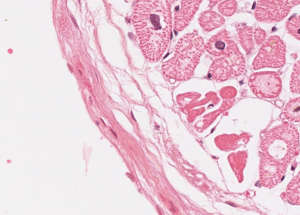 |
| innermost layer of the lymphatics | | 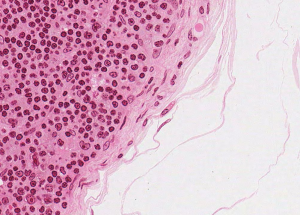 |
| external surfaces of internal organs | a.g.a. mesothelium | 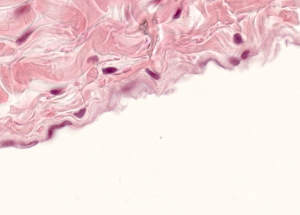 |
| walls of alveoli (lungs) | | |
Source: https://uta.pressbooks.pub/histology/chapter/epithelial-tissues/
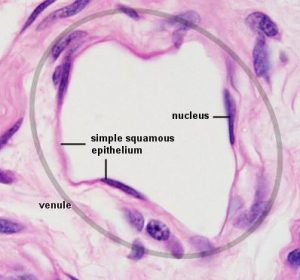
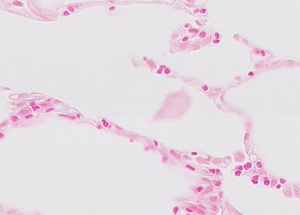
0 Response to "Epithelial Tissue That Can Stretch or Is Subjected to Stress Would Have Many"
Post a Comment